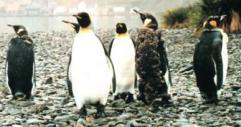This is an old revision of this page, as edited by Jimfbleak (talk | contribs) at 09:17, 6 April 2003 (For an alternative taxonomy, see also Sibley-Alquist taxonomy.). The present address (URL) is a permanent link to this revision, which may differ significantly from the current revision.
Revision as of 09:17, 6 April 2003 by Jimfbleak (talk | contribs) (For an alternative taxonomy, see also Sibley-Alquist taxonomy.)(diff) ← Previous revision | Latest revision (diff) | Newer revision → (diff)Penguins (Sphenisciformes) are an order of flightless birds living in the southern hemisphere.
 |
| Public domain picture from U.S. National Oceanic and Atmospheric Administration |
They are mostly found in cold climates (including the pack ice of Antarctica), although some species live as far north as the Galapagos Islands and will occasionally cross the equator while feeding. Most penguins live off fish, squid, and other forms of sealife that they catch while swimming underwater.
The largest species of penguin is the emperor penguin; adults of this species average about 1.1 meter tall and mass 30 or more kilograms. The smallest penguin species is the little penguin (also known as the Fairy Penguin), which is typically 35 to 40 cm tall and 1 kilogram. Generally larger penguins retain heat better and thus inhabit colder regions, while smaller penguins are found in temperate or even tropical climates.
Penguins emerged in the Eocene era 40 million years ago. These birds, e.g. Palaeeudyptes from the Eocene or Pachydyptes from the Miocene resembled modern penguins. The links between other bird orders and penguins are still unknown. A distant relationship between penguins and petrels is assumed, but not proved. Most fossil penguins known were large, but not larger than the recent emperor penguin. All of them lived in the southern hemisphere.
Anatomy
Penguins are greatly adapted to an aquatic life. Their wings have become flippers. They are useless for flight in the air, but penguins seem to fly under water. Within the smooth plumage a layer of air is preserved ensuring buoyancy in water. This is the reason, why a chain of air bubbles stretches behind a diving penguin. The air layer makes also insensitive to the icy water temperatures in antarctic climes. The plumage of the penguins in tropical and temperate zones is much thinner.
All penguins have a white underside and a dark (mostly black) upperside. This is for camouflage. An enemy looking from below (e.g. a killer whale or a leopard seal) can't distinguish between a white penguin belly and the reflecting water surface.
Diving penguins reach 7 to 10 km/h, though there are reports about velocities of 27 km/h (which may be realistic in the case of precipitate flight). The small penguins don't dive deep. Their prey is caught near the surface, and one to two minutes after diving they come up again. The emperor penguin reaches depths of 50 to 265 m.
When going ashore, penguins have a clumsy appearance. They either waddle on their feet or slide on the belly across the snow.
Penguins have excellent sense of hearing. Their eyes are adapted for vision under water. In air they don't work well, and here the penguins are near-sighted. The sense of smell has not been researched so far.
Classification
All penguins below to one order (Sphenisciformes) and one family (Spheniscidae).
For an alternative taxonomy, see Sibley-Alquist taxonomy.
The genera and species of penguins are:
- Aptenodytes
- Aptenodytes forsteri, emperor penguin
- Aptenodytes patagonicus, king penguin
- Eudyptes
- Eudyptes chrysocome, rockhopper penguin
- Eudyptes chrysolophus, macaroni penguin
- Eudyptes schlegeli, royal penguin
- Eudyptes pachyrhynchus, Fiordland penguin
- Eudyptes sclateri, erect-crested penguin
- Eudyptes robustus, Snares penguin
- Pygoscelis
- Pygoscelis adeliae, Adelie penguin
- Pygoscelis antarctica, chinstrap penguin
- Pygoscelis papua, gentoo penguin
- Spheniscus
- Spheniscus demersus, African penguin
- Spheniscus magellanicus, Magellanic penguin
- Spheniscus humboldti, Humboldt penguin
- Spheniscus mendiculus, Galapagos penguin
- Megadyptes
- Megadyptes antipodes, yellow-eyed penguin
- Eudyptula
- Eudyptula minor, little penguin
Miscellaneous
The name "penguin" was originally applied to another bird, the great auk, formerly found in Newfoundland and on other islands off the Canadian coast, but now extinct. Indeed the auks look a little bit like penguins, but they are not related with them. "Penguin" is thought by some to derive from the Welsh words pen (head) and gwyn (white), applied to the great auk, which had a conspicuous white patch between the bill and the eye (although its head was black), or from an island off Newfoundland known as "White Head". According to another theory, the original name was "pen-wing", with reference to the rudimentary wings of both great auks and penguins. A third (not widely accepted) theory is that "penguin" comes from the Latin pinguis (fat).
The Linux logo/mascot Tux is a penguin.
Other meanings:
A British publisher - see Penguin Books
A supervillain who is encountered in the Batman comic books.
A missile, see Penguin missile.